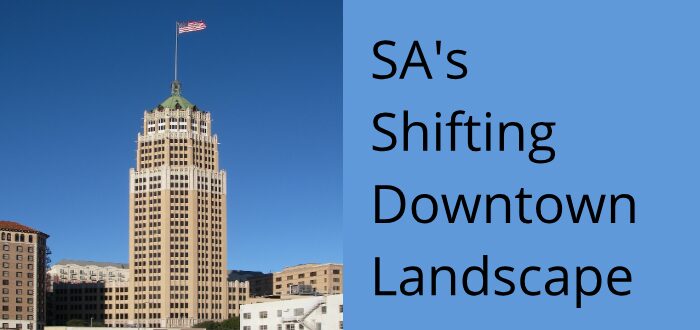Preserving the Old and Constructing the New in San Antonio
March 23, 2023

February’s Letter was about the Tug-of-War between worker shortages we are facing and the need to tamp down high inflation. Let’s now talk about the places where about one-third do their work – offices.
Fast Fact – Women comprise about 70% of the office workforce and men 30%.
Commercial Property Price Index
Green Street Research is the most respected Commercial Real Estate analyst company and their Commercial Property Price Index, which tracks all sectors of CRE, has fallen 15% in the past year from its peak in March of 2022. Office prices are down even more, with a decline of 17%, and their decline is now accelerating with a 4% decline in January alone.
Commercial Real Estate is Feeling the Squeeze
Rising interest rates have put the brakes on commercial real estate sales, according to the national brokerage firm, CBRE. Awkwardly, many commercial properties have loans coming due, which may become difficult and expensive to refinance. Others may not be able to pay their mortgages as costs, like property taxes and finish out, rise along with vacancies due to the current earnings recession. Class A properties are attracting good tenants, but Class B and Class C buildings are feeling the brunt of the squeeze.
San Antonio Vacancy Rates, Best and Worst
Let’s focus on one of the most important places for office workers in San Antonio – Downtown, also known as The Central Business District. This is where about 70,000 people work daily, out of our 1.2-million labor force.
Overall, office vacancy in San Antonio has spiked to 20% year over year, by far the largest vacancy increase in Texas metro areas. Downtown being the worst with over 30% vacancy, according to Stream Realty. The best area of the city is the Northwest quadrant, including the IH-10 Corridor, Medical Center extending out to La Cantera and The Rim.
Work-From-Home, a Corporate Employee Retaining Strategy
USAA recently announced they are leaving downtown, departing the 500,000 SF Bank of America Plaza and One Riverwalk Place, both of which they own, to consolidate those 500 employees back to their IH-10 Main Campus. USAA is known to be one of the best places to work in the U.S. and they relied on Work- From-Home (WFH) to keep up their customer service during the pandemic. Now, they want more workers to return to in-office work. So, with even one-third of their workers still WFH, they need less office space and calculate they will save $31-million a year by leaving Downtown and other downsizings.
Nationwide, it’s estimated that about one-third of workers are still working remotely full-time or part of the week. For some businesses, this has become the best solution to retaining good workers, getting the job done and still maintaining a cohesive business.
Demand for office space has slowed since the pandemic as more people work from home and employers reduce their rental space footprint, just like USAA leaving and consolidating on their 5-million Square Foot northwest campus.
Years ago, USAA tried a four-day work week with 10 hour days and Fridays off, but it didn’t stick. Now, post-pandemic across the country the concept of the hybrid 3-day-in-office workweek is taking hold, with Tuesday, Wednesday and Thursday in-office and WFH Monday and Friday.
It’s a balancing act. Supervisors want to see more collaboration and team building, while 20-something new-hires want the face-to-face training they need to advance their careers, but everyone likes an extra day or two working remotely.
“Times are a’Changin” (Bob Dylan, 1964 for you 20-somethings).
The Office-to-Apartment Transformation of Downtown
“Downtown” (Petula Clark, 1964) has a very high vacancy rate and then pile on that less than two-thirds of the workers are actually in the office, depending on the day of the week. Parking on Mondays should be easy. Meanwhile, older Class B and C office buildings are “becoming functionally obsolete,” stated a report by the Urban Land Institute and the National Multifamily Housing Council.
“Demand for office space is anticipated to grow more slowly post-pandemic than in the past and be more focused on newer stock.” We see that only the new Class A buildings near The Pearl are generating much new leasing interest.
As a result, San Antonio is joining a national trend whereby old office buildings are being converted into something new, like apartments or hotels. Office-to-apartment conversions in the U.S. are at an all-time high, according to the apartment search site RentCafe.
In our Fair City, take for example The Milam Building, built in 1928 and the first all air-conditioned building in the U.S., which was bought by Weston Urban in 2016 and will probably be converted to apartments.
The iconic Tower Life Building is being converted to multi-family by a local group of investors headed by Ed Cross and Nix Hospital was purchased several years ago also for conversion to apartments.
Then there is the old CPS headquarters on the Riverwalk next to La Villita that will become a 243-room $55-million hotel dubbed El Portal with River level restaurants.
Riverview Tower, located at 111 Soledad, was recently purchased for conversion from offices to a dual-branded Marriott. If we include the Cavender Cadillac to Soto Office building conversion and The Pearl we see there will be a new second life for these beautiful old buildings.
New Construction
There is a considerable amount of new construction, too. Weston Urban has broken ground on a 32-story residential tower at 300 Main, and the new UTSA San Pedro II education building has broken ground at the San Pedro Creek Parkway and Dolorosa, to join its sister, the just-opened 167,000 SF San Pedro I School of Data Science and National Cybersecurity Collaboration.
Preserving the old and constructing the new is San Antonio’s way for our places to work.

